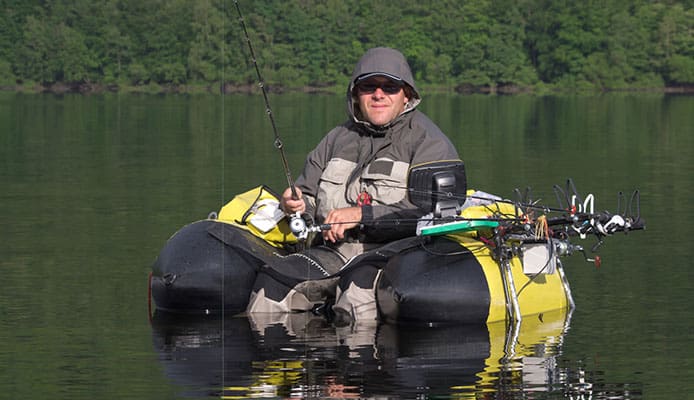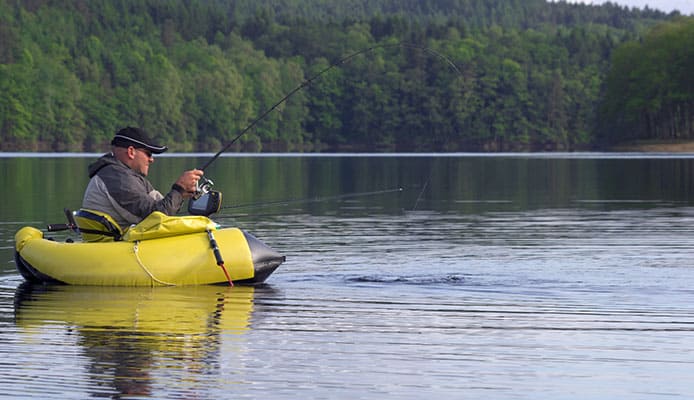
Using a fishing float tube is one of the most effective ways to catch fish. Not only does it allow you to fish backwood lakes and ponds you can’t access by boat or on foot, but it also moves stealthily in the water allowing you to get close to the fish without scaring them away. These advantages make float tube fishing incredibly fun, relaxing, and rewarding.
However, fishing float tubes have their own set of challenges. For example, they are not the easiest fishing vessels to maneuver especially when the wind is blowing against you. Because of this, using a float tube for fishing requires careful planning. Here, we’ll give you some float tube fishing tips you can use to make the most of your float tube fishing trips.
1. Make Sure You Have Everything You Need
The first thing you need to do before you head out into the water is to make sure you have everything you’ll need for the trip. In addition to the flyfishing float tube, life vest/Pfds, waders, fins, and fishing gear and tackle, there are several other things you’ll want to bring with you on the water so you have a comfortable fishing experience.
These include snacks and water to keep your strength up and keep you hydrated. We also advise packing a pair of ping pong paddles. These come in handy in instances where you need extra power to move your float tube. Since you’re bound to get wet, it’s wise to bring along a change of clothing as well. Lastly, don’t forget to pack your cell phone and other valuables in waterproof phone cases or dry bags.
2. Wear Sunscreen and Insect Repellant
When you go float tube fishing, you’ll be exposed to the sun’s rays for quite a while (even on overcast days). Thus, be sure to apply waterproof sunscreen to prevent sunburn and ward off other negative effects of exposure to ultraviolet rays.
If you’ll be fishing in backwaters teeming with disease-carrying mosquitoes and insects, you should also consider applying insect repellant to keep the bugs at bay.
3. Dress Appropriately
Since your feet and legs will be in contact with cold water, it’s very important to dress warmly when fishing from a float tube. Thick leggings, pants, and socks are essential to stay warm and fend off hypothermia. Some float tube fishermen even wear wetsuits to stay warm.
Being so close to the water, you’re also very susceptible to reflective sunburn. Besides a sun protection hat and sunscreen, you will need a pair of polarized sunglasses to cut off glare, protect your eyes, and enable you to see clearly.
4. Wear Waders
Still on the topic of dressing, wearing a pair of waders when fly fishing from a float tube is a good idea. It will keep you dry and warm and protect you from abrasion, insects, leeches, and other creatures.
Neoprene fly fishing waders come in different thicknesses depending on the kind of conditions you will be fly fishing in. The thicker a pair of waders is, the more insulating and warm it is.
5. Stay Visible
One advantage of fishing backwater waters is that you usually don’t have to worry about motorboats’ traffic. However, it’s still important to remain visible while on this kind of water.
Using a colorful float tube or raising a brightly colored flag behind should be enough to make sure you can be easily spotted by other fishermen or rescuers in the event of an emergency. If you prefer using a dark-colored float tube that blends into the surroundings, wear brightly colored clothing to ensure visibility.
You may also like:
How To Set Up Your Kayak For Fishing
6. Bring the Right Fishing Tackle
Float tubes simply don’t have the kind of storage capacity you have when fishing with a kayak or boat. While there’s a wide variety of lures you can use when float tube fishing, you won’t be able to bring a lot of fishing tackle with you. Thus, it’s smart to organize your fishing tackle beforehand to ensure you don’t forget the essentials.
If your fly fishing tube is large enough, you might be able to fit in two fly boxes on the tube. To make the most of your trip, make sure you load these boxes with the best flies and lures for the fish species you are targeting and the water you’re fishing.
7. Bring the Right Fishing Rod

The kind of fishing rod you use will determine how successful your float tube fishing trips will be. Generally, longer fly rods between nine and twelve feet are ideal for casting from fly fishing float tubes. They will allow you to cast a good distance while seated in your float tube.
However, it’s still important to match your fishing rod with the species of fish you are after. The right rod will also depend on the fishing techniques you will be employing. Besides float tube fly fishing techniques, slow trolling from a float tube is very effective too as long as you have the right rod.
8. Choose The Right Fishing Reel
A level wind reel or a single action reel is the go-to fishing reel for most float tube fishermen. Accordingly, single-action reels are considered the best reels for float tube fishing as they have excellent line capacities and feed out the line smoothly as well.
A level wind reel also performs flawlessly while fishing off a float tube and has the added advantage of being versatile so you can use it for other types of fishing.
9. Use Razor-sharp Hooks
It’s also important to bring along high-quality razor-sharp hooks, otherwise, you may see many of the fish hook into swim away. Besides the quality, the size is also an important consideration when buying fishing hooks.
If you float tube fishing in clear water and target small fish, then smaller hooks are fine. If you are after larger fish, then you will need larger hooks. However, these hooks can puncture your float tube so you must handle and store them carefully.
10. Don’t Go too Far Out
Unlike fishing kayaks and other types of fishing vessels, flyfishing float tubes are not very fast or easy to maneuver. This means you won’t be able to cover a lot of water. Due to this, it’s crucial to enter the water close to the spot you plan to fish and stay as close to shore as possible.
Also, going too far out in such a small vessel puts you at the mercy of the elements (wind, current, etc.). If you go too far out, you’ll have a hard time returning to shore at the end of the day or in the event of an emergency such as a puncture.
11. Take Advantage of the Wind
One of the challenges of float tube fly fishing is that wind blowing against you can make it very hard to stay in position or maneuver the tube to where you want it to go.
However, the wind blowing in your direction is your friend as it can make maneuvering your float tube a breeze. You can take advantage of this on your return journey so you can get to the shore quickly.
12. Keep an Eye on the Clock
Last but certainly not least on our float tube fishing tips, always keep an eye on the clock. This is especially crucial if you are fishing late in the afternoon. It’s very easy to get engrossed in the activity only to look up and discover that night is approaching.
It can be a challenge to maneuver a float tube back to shore especially because your energy levels won’t be high after a long day fishing. Darkness can make it even more difficult for you to maneuver the float tube. Due to this, we recommend giving yourself an hour or two for getting back to shore.
Globo Surf Overview
Float tubes give you the advantages of access and stealth when fishing in backwoods lakes, ponds, and sedate rivers. The absence of motor vibration or clunking sounds and large boat shadows allow you to sneak in and bag the fish you’re after.
Still, fishing from a float tube is very different from fishing from a kayak or boat, which is why we’ve outlined some float tube fishing tips to help make this adventure safer and more successful for you. Keep them in mind when planning your fishing trips and you’re set up for enjoyable and successful float fishing excursions.
More Kayak Reviews:
- Tandem Fishing Kayaks
- Stand Up Fishing Kayaks
- Ocean Fishing Kayaks
- Sit On Top Fishing Kayaks
- Kayak Paddles For Fishing
- Kayak Fishing Accessories
- Pedal Fishing Kayaks
- Kayak Fishing Rods
- River / Fly Fishing Kayaks
- Kayak Fishing Nets
- Modular Fishing Kayaks
- Kayak Fish Finders
- Kayak Tackle Boxes
- Kayak Knives
Single Fishing kayak Reviews:
- Sevylor Coleman Colorado 2-Person Fishing Kayak Review
- Kayak Crabbing Guide – Everything You Need To Know
- Elkton Outdoors Cormorant Inflatable 2 Person Fishing Kayak Review

